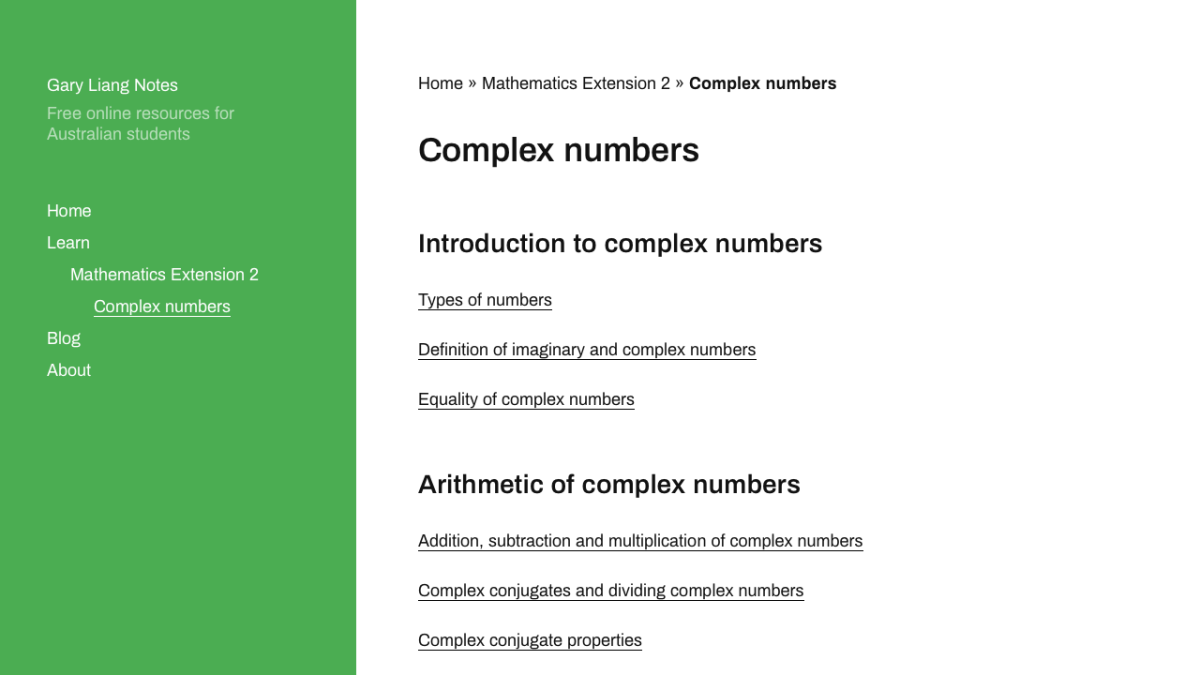GL Notes - Complex Numbers
https://glnotes.com/mathematics-extension-2/complex-numbers/
Explanation, Practise, Proof, Reference, Resources, Revision, Summary, Worksheet - Electronic
Complete online textbook, explanation and problems for Complex Numbers
10 May 2020 Edit: 10 May 2020
User submitted, thanks to Gary Liang
- Topics:
- Advanced, Complex Numbers
- Content Type:
- Explanation, Practise, Proof, Reference, Resources, Revision, Summary, Worksheet - Electronic
- Australian Curriculum / Specialist Mathematics
- Unit 2 Topic 3 Real and complex numbers, Complex numbers:, ACMSM067 define the imaginary number ii as a root of the equation x2=−1x2=-1, ACMSM068 use complex numbers in the form a+bia+bi where aa and b b are the real and imaginary …, ACMSM069 determine and use complex conjugates, ACMSM070 perform complex-number arithmetic: addition, subtraction, multiplication and division…, The complex plane:, ACMSM071 consider complex numbers as points in a plane with real and imaginary parts as Cartes…, ACMSM072 examine addition of complex numbers as vector addition in the complex plane, ACMSM073 understand and use location of complex conjugates in the complex plane., Roots of equations:, ACMSM074 use the general solution of real quadratic equations, ACMSM075 determine complex conjugate solutions of real quadratic equations, ACMSM076 determine linear factors of real quadratic polynomials., Unit 3 Topic 1 Complex numbers, Cartesian forms:, ACMSM077 review real and imaginary parts Re(z) Rez and Im(z)Im(z) of a complex number zz, ACMSM078 review Cartesian form, ACMSM079 review complex arithmetic using Cartesian forms., Complex arithmetic using polar form:, ACMSM080 use the modulus ∣∣z∣∣zof a complex number z and the argument Arg (z)Arg (z) of a non-…, ACMSM081 convert between Cartesian and polar form, ACMSM082 define and use multiplication, division, and powers of complex numbers in polar form …, ACMSM083 prove and use De Moivre’s theorem for integral powers., The complex plane (the Argand plane):, ACMSM084 examine and use addition of complex numbers as vector addition in the complex plane, ACMSM085 examine and use multiplication as a linear transformation in the complex plane, identify subsets of the complex plane determined by relations such as∣∣z−3i∣∣≤4z-3i≤4, ACMSM086 π4≤Arg(z)≤3π4π4≤Arg(z)≤3π4, Re(z)>Im(z)Rez>Im(z) and ∣∣z−1∣∣=2∣∣z−i∣∣z-1=2, Roots of complex numbers:, ACMSM087 determine and examine the nthnth roots of unity and their location on the unit circle, ACMSM088 determine and examine the nthnthroots of complex numbers and their location in the co…, Factorisation of polynomials:, ACMSM089 prove and apply the factor theorem and the remainder theorem for polynomials, ACMSM090 consider conjugate roots for polynomials with real coefficients, ACMSM091 solve simple polynomial equations.
- NSW Mathematics Extension 2 Stage 6 Syllabus
- Complex Numbers, MEX-N1 Introduction to Complex Numbers, MEX N1.1 Arithmetic of complex numbers, MEX N1.2 Geometric representation of a complex number, MEX N1.3 Other representations of complex numbers, MEX-N2 Using Complex Numbers, MEX N2.1 Solving equations with complex numbers
- NSW Mathematics Extension 2 Year 12 Syllabus (2024) New
- Complex numbers, Introduction to complex numbers, Geometric representation of complex numbers, Solving equations with complex numbers
Submit a correction to this link | Help align this link to NSW Mathematics Syllabuses

Comments
How have you used this link in your classroom? Share your teaching ideas or leave a review about this link.
Sign in to leave a comment.
There are no comments for this link.